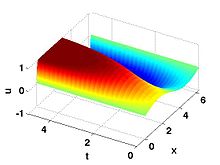Allen–Cahn equation

The Allen–Cahn equation (after John W. Cahn and Sam Allen) is a reaction–diffusion equation of mathematical physics which describes the process of phase separation in multi-component alloy systems, including order-disorder transitions.
The equation describes the time evolution of a scalar-valued state variable on a domain during a time interval , and is given by:[1][2]
where is the mobility, is a double-well potential, is the control on the state variable at the portion of the boundary , is the source control at , is the initial condition, and is the outward normal to .
It is the L2 gradient flow of the Ginzburg–Landau free energy functional.[3] It is closely related to the Cahn–Hilliard equation.
Mathematical description
[edit]Let
- be an open set,
- an arbitrary initial function,
- and two constants.
A function is a solution to the Allen–Cahn equation if it solves[4]
where
- is the Laplacian with respect to the space ,
- is the derivative of a non-negative with two minima .
Usually, one has the following initial condition with the Neumann boundary condition
where is the outer normal derivative.
For one popular candidate is
References
[edit]- ^ Allen, S. M.; Cahn, J. W. (1972). "Ground State Structures in Ordered Binary Alloys with Second Neighbor Interactions". Acta Metall. 20 (3): 423–433. doi:10.1016/0001-6160(72)90037-5.
- ^ Allen, S. M.; Cahn, J. W. (1973). "A Correction to the Ground State of FCC Binary Ordered Alloys with First and Second Neighbor Pairwise Interactions". Scripta Metallurgica. 7 (12): 1261–1264. doi:10.1016/0036-9748(73)90073-2.
- ^ Veerman, Frits (March 8, 2016). "What is the L2 gradient flow?". MathOverflow.
- ^ Bartels, Sören (2015). Numerical Methods for Nonlinear Partial Differential Equations. Deutschland: Springer International Publishing. p. 153.
Further reading
[edit]- http://www.ctcms.nist.gov/~wcraig/variational/node10.html
- Allen, S. M.; Cahn, J. W. (1975). "Coherent and Incoherent Equilibria in Iron-Rich Iron-Aluminum Alloys". Acta Metall. 23 (9): 1017. doi:10.1016/0001-6160(75)90106-6.
- Allen, S. M.; Cahn, J. W. (1976). "On Tricritical Points Resulting from the Intersection of Lines of Higher-Order Transitions with Spinodals". Scripta Metallurgica. 10 (5): 451–454. doi:10.1016/0036-9748(76)90171-x.
- Allen, S. M.; Cahn, J. W. (1976). "Mechanisms of Phase Transformation Within the Miscibility Gap of Fe-Rich Fe-Al Alloys". Acta Metall. 24 (5): 425–437. doi:10.1016/0001-6160(76)90063-8.
- Cahn, J. W.; Allen, S. M. (1977). "A Microscopic Theory of Domain Wall Motion and Its Experimental Verification in Fe-Al Alloy Domain Growth Kinetics". Journal de Physique. 38: C7–51.
- Allen, S. M.; Cahn, J. W. (1979). "A Microscopic Theory for Antiphase Boundary Motion and Its Application to Antiphase Domain Coarsening". Acta Metall. 27 (6): 1085–1095. doi:10.1016/0001-6160(79)90196-2.
- Bronsard, L.; Reitich, F. (1993). "On three-phase boundary motion and the singular limit of a vector valued Ginzburg–Landau equation". Arch. Rat. Mech. Anal. 124 (4): 355–379. Bibcode:1993ArRMA.124..355B. doi:10.1007/bf00375607. S2CID 123291032.
External links
[edit]- Simulation by Nils Berglund of a solution of the Allen–Cahn equation




![{\displaystyle {{\partial \eta } \over {\partial t}}=M_{\eta }[\operatorname {div} (\varepsilon _{\eta }^{2}\nabla \,\eta )-f'(\eta )]\quad {\text{on }}\Omega \times {\mathcal {T}},\quad \eta ={\bar {\eta }}\quad {\text{on }}\partial _{\eta }\Omega \times {\mathcal {T}},}](https://wikimedia.org/api/rest_v1/media/math/render/svg/19e8f302d7b872a9a91ef5a7d0f1cd63bc976122)














![{\displaystyle v(x,t):\Omega \times [0,T]\to \mathbb {R} }](https://wikimedia.org/api/rest_v1/media/math/render/svg/138bdc13cdbc1d322fd8abaa2ac283a8cc8b0d06)
![{\displaystyle \partial _{t}v-\Delta _{x}v=-{\frac {1}{\varepsilon ^{2}}}f(v),\quad \Omega \times [0,T]}](https://wikimedia.org/api/rest_v1/media/math/render/svg/79cce9fec793ef2dbfe6004398e8ca6d4923e84e)





![{\displaystyle {\begin{cases}v(x,0)=v_{0}(x),&\Omega \times \{0\}\\\partial _{n}v=0,&\partial \Omega \times [0,T]\\\end{cases}}}](https://wikimedia.org/api/rest_v1/media/math/render/svg/d476d9cac5f2e076e6e7743aee68a8b458ab053b)


